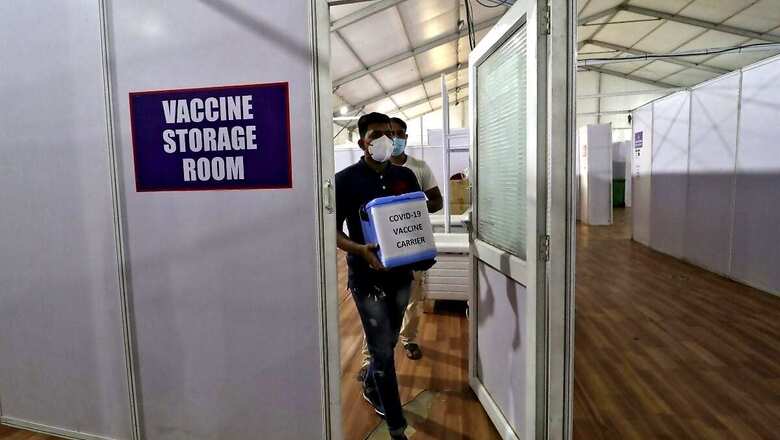
views
India will launch its most ambitious and the world’s largest Covid-19 vaccination drive on Saturday. Inoculating the country’s vast and distributed population is a big challenge but India’s past experience in mass vaccination will come in handy here.
The current Covid-19 vaccination drive also leans heavily on processes, manpower, database and experience of the Universal Immunisation Programme that vaccinated over 27 million pregnant women and 25 million infants every year.
Much before modern vaccine interventions were developed in the West and brought to India by the British, this important and cost-effective public health intervention tool was well known to Indians. Ancient literary evidence suggests smallpox inoculation was practised in India and a few other countries as early as 1000 AD, writes Dr Chandrakant Lahariya, a leading health system expert, in an article published in the Indian Journal of Medical Research.
The vintage technique known as ‘variolation’ involved injecting a healthy person with an infective agent extracted from a patient or a variolated person. This led to mild illness but saved the person from serious infection in the future. However, the procedure was risky as there were chances of infection spreading and even death.
In 1798, English physician Edward Jenner discovered the smallpox vaccine. Within four years, this vaccine landed in Bombay via Baghdad. On June 14, 1802, three-year old Anna Dusthall became the first Indian to receive this vaccine in Bombay. To overcome the logistical problem, a vaccine human chain was developed starting with Dusthall, and it soon reached other parts of the country.
Around India’s Independence, tuberculosis had started raising its ugly head. After careful consideration, the government was pressed to launch independent India’s first BCG vaccination drive in 1948, although on a limited scale and under strict supervision. The same year on May 1, a BCG vaccine laboratory was set up at King Institute at Guindy in Madras. The next year, the BCG vaccination drive was extended to almost all schools across India and in 1962, BCG vaccination became a part of the National Tuberculosis Control Programme, acquiring sort of universal coverage.
Though small pox vaccination in the country had British roots but in 1967-68, the government changed the vaccination strategy, focussing more on surveillance and rapid containment drives. In between, a more superior ‘bifurcated needle’ vaccination technique was introduced, which required less vaccine material for each dose, and inoculation was relaxing than previous methods. Besides, in 1971, higher quality freeze-dried vaccine replaced liquid vaccine vials. These new methods led to significant uptick in small pox vaccination coverage while restricting the disease to few pockets of the country, including Uttar Pradesh, Bihar and West Bengal. On April 23, 1977, India was declared free of deadly small pox.
Small pox eradication, while an important milestone in disease prevention, also gave India’s public health system a confidence of overcoming odds besides providing trained manpower and vaccination infrastructure. Buoyed by its success, the Janata government in 1978 launched National Immunization programme as ‘Expanded Programme of Immunization’. The main objective of this ambitious programme was to reduce morbidity and mortality from diphtheria, pertussis, tetanus, poliomyelitis and childhood tuberculosis.
In 1985, the programme was modified as ‘Universal Immunization Programme’ with a target of covering all districts of the country by 1989-90. It was one of largest health programmes in the world and included vaccines of BCG, OPV, DPT, tetanus and measles. In 1986, India’s immunization programme received a major boost after it was given the status of one of the five National Technology Missions, the other being drinking water, literacy, oil seed production, and telecommunication.
However, the story of India’s success in vaccination couldn’t be completed without mentioning its polio immunization programme. Following World Health Assembly resolution in 1988, India launched its massive Pulse Polio immunisation programme in 1995. The aim was 100% immunization coverage for age group of 0-5 with oral polio vaccine through improved social mobilization. In 1999, the vaccination drive was moved from booth activity to door to door coverage.
The dogged pursuit soon bore fruit. The last polio case in the country, according to the Health Ministry, was reported from Howrah district in January 2011. The World Health Organization (WHO) in February 2012 removed India from the list of active polio endemic countries. Despite this success, India hasn’t let its guard down. About 172 million children are immunized against polio during each National Immunization Day each year.
India’s current immunization programmes remain robust and organic, with new vaccines added from time to time and as per the needs. In 2014, the NDA government launched its flagship vaccination programme – the “Mission Indradhanush” (MI). The aim is to protect children and pregnant women against seven vaccine-preventable diseases. While some of the redundant vaccines have been replaced, few others like vaccine for Hepatitis B, Japanese encephalitis, meningitis have made it to the list.
Read all the Latest News, Breaking News and Coronavirus News here




















Comments
0 comment